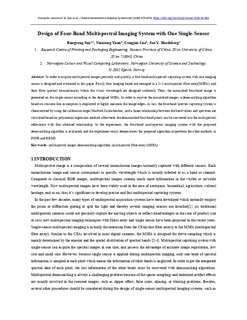| dc.contributor.author | Sun, Bangyong | |
| dc.contributor.author | Yuan, Nianzeng | |
| dc.contributor.author | Cao, Congjun | |
| dc.contributor.author | Hardeberg, Jon Yngve | |
| dc.date.accessioned | 2019-04-29T10:48:02Z | |
| dc.date.available | 2019-04-29T10:48:02Z | |
| dc.date.created | 2018-11-22T16:42:53Z | |
| dc.date.issued | 2018 | |
| dc.identifier.citation | Future generations computer systems. 2018, 86 670-679. | nb_NO |
| dc.identifier.issn | 0167-739X | |
| dc.identifier.uri | http://hdl.handle.net/11250/2595918 | |
| dc.description.abstract | In order to acquire multispectral images precisely and quickly, a four-band multispectral capturing system with one imaging sensor is designed and evaluated in this paper. Firstly, four imaging bands are arranged in a 22 multispectral filter array (MSFA), and their filter spectral transmittances within the visual wavelength are designed uniformly. Then, the mosaicked four-band image is generated on the single-sensor according to the designed MSFA. In order to recover the mosaicked images, a demosaicking algorithm based on constant hue assumption is employed to highly maintain the image edges. At last, the four-band spectral capturing system is characterized by using the calibration target Macbeth ColorChecker, and a linear relationship between the band values and spectrum are calculated based on polynomial regression method, afterwards the demosaicked four-band pixels can be converted into the multispectral reflectance with that obtained relationship. In the experiment, the four-band multispectral imaging system with the proposed demosaicking algorithm is evaluated, and the experiment result demonstrates the proposed algorithm outperform the other methods in PSNR and RRMS. | nb_NO |
| dc.language.iso | eng | nb_NO |
| dc.publisher | Elsevier | nb_NO |
| dc.rights | Attribution-NonCommercial-NoDerivatives 4.0 Internasjonal | * |
| dc.rights.uri | http://creativecommons.org/licenses/by-nc-nd/4.0/deed.no | * |
| dc.title | Design of four-band multispectral imaging system with one single-sensor | nb_NO |
| dc.type | Journal article | nb_NO |
| dc.type | Peer reviewed | nb_NO |
| dc.description.version | acceptedVersion | nb_NO |
| dc.source.pagenumber | 670-679 | nb_NO |
| dc.source.volume | 86 | nb_NO |
| dc.source.journal | Future generations computer systems | nb_NO |
| dc.identifier.doi | 10.1016/j.future.2018.04.056 | |
| dc.identifier.cristin | 1633949 | |
| dc.description.localcode | © 2018. This is the authors’ accepted and refereed manuscript to the article. Locked until 2 May 2020 due to copyright restrictions. This manuscript version is made available under the CC-BY-NC-ND 4.0 license http://creativecommons.org/licenses/by-nc-nd/4.0/ | nb_NO |
| cristin.unitcode | 194,63,10,0 | |
| cristin.unitname | Institutt for datateknologi og informatikk | |
| cristin.ispublished | true | |
| cristin.fulltext | original | |
| cristin.qualitycode | 1 | |

